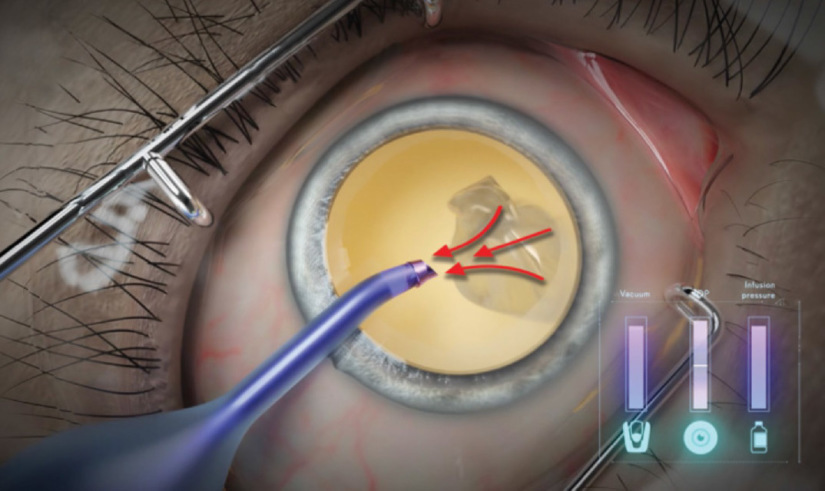Stellaris Elite® Is Optimized for Cutting Efficiency
Dr. K. Alex Dastgheib is in private practice in Garden Grove and Newport Beach, California with more than 20 years’ experience in cataract surgery. He has successfully performed a very large number of surgeries in patients with extremely advanced, visually significant cataracts using phacoemulsification.
Dr. Dastgheib noted that “Stellaris Elite is my favorite and preferred platform” for cataract surgery. The cutting efficiency and followability of the Stellaris Elite vacuum-based phacoemulsification platform set it apart from the competition. Stellaris Elite can be used for all cataract surgery patients, not just the most difficult cases.
Optimized Cutting Efficiency with Stellaris Elite
Stellaris Elite includes Attune® Energy, which optimizes energy delivery so that only the minimal amount of energy necessary is used. This enables the surgeon to use only the ultrasound energy that is needed, thus minimizing the amount of heat used and therefore minimizing the risk of postoperative corneal edema. However, when a greater amount of energy is required, such as with dense cataracts, more ultrasound energy can be applied and the phaco tip will easily go through the nucleus. Thus, exceptionally efficient cutting can be achieved at a variety of power settings, depending on what is needed for a specific case.1
Stellaris Elite uses a microincisional cataract surgery (MICS) needle, which has a 0.142 mm stroke length and a 0.79 mm opening area. The MICS needle can be inserted through an incision of less than 2 mm and gets through dense cataracts very well in Dr. Dastgheib’s experience. The small incision size helps to maintain chamber stability. Chamber stability is especially important in cases with a risk of chamber collapse, narrow angle eyes, short eyes, and floppy iris syndrome.
Dr. Dastgheib prefers the longitudinal cutting action of Stellaris Elite over a torsional cutting action. In his experience, he can see the phaco tip in the eye clearly and thus has exceptional control over where the tip is when using the longitudinal motion. Being able to see where the tip is allows him to adapt to any changes inside the eye very quickly. Dr. Dastgheib “feels very comfortable with the cutting action of Stellaris Elite.”
Exceptional Followability with Stellaris Elite
Another key advantage of Stellaris Elite for Dr. Dastgheib is the excellent followability. As the surgeon increases the vacuum, pieces of the cataract move towards the tip due to followability. The surgeon does not need to maneuver the tip in the eye or get close to the capsular bag to reach for cataract segments within the capsular bag. Instead, the piece moves to the needle, creating excellent chamber stability.
During a cataract procedure, he can increase the vacuum and the piece of cataract will move to the tip. “This is a big deal.”

“The followability with Stellaris Elite is excellent and that makes a big difference during cataract surgery. This is especially true with dense cataracts. I don’t want to go fishing for pieces close to the capsule.”
– Dr. K. Alex Dastgheib
Proactive Chamber Stability
Stellaris Elite is the only phaco system that proactively monitors infusion pressure and automatically compensates for changes in pressure using Adaptive Fluidics™ technology to deliver exceptional chamber stability.1,3 With cataract surgery, after significant nuclear volume has been removed, there is a risk of the posterior capsule trampolining. With flow-based phaco machines, a post-occlusion surge can occur due to the high vacuum during an adjustment period and this can lead to pulling the capsule into the phaco needle. However, with Stellaris Elite, chamber stability is three times higher and there is a reduced risk of post-occlusion surge, compared to Alcon Centurion.1 This helps ensure capsular integrity.
Stellaris Elite’s Adaptive Fluidics system proactively adapts to the commanded vacuum. Control over vacuum is in the hands of the surgeon and direct occlusion is not needed to control the level of vacuum.
A 58-year-old painter with no light perception in his left eye and light perception vision in the right eye presented for evaluation. He had a rock-hard cataract in the right eye. Dr. Dastgheib performed cataract surgery on this patient. Following surgery this painter had 20/25 vision. He was able to return to work and support his family. The patient and his family are incredibly grateful for the improvement in quality of vision post-cataract surgery.
“I try to use Stellaris whenever possible. I am a conservative surgeon and I think this machine is the right platform for both me and the patient.”
– Dr. K. Alex Dastgheib
To learn more about the Stellaris Elite system, please go to www.bauschsurgical.com. Connect with a representative today if you would like to hear more about how to demo the system in your OR.

Dr. K. Alex Dastgheib completed his residency in ophthalmology at Duke University and 4 fellowships at the Wilmer Eye Institute, Johns Hopkins, the National Eye Institute, NIH, the Dubroff Eye Center, Maryland, and the John A. Moran Eye Center, University of Utah. The Dastgheib Pioneer Award in Ocular Innovation, established in 2014, is given annually at Duke University for his pioneering work in 1992–1994 in establishing the presence of VEGF in neovascular AMD. Recipients of this award have made a major change in the practice of ophthalmology.
Financial disclosure: consultant to Bausch + Lomb